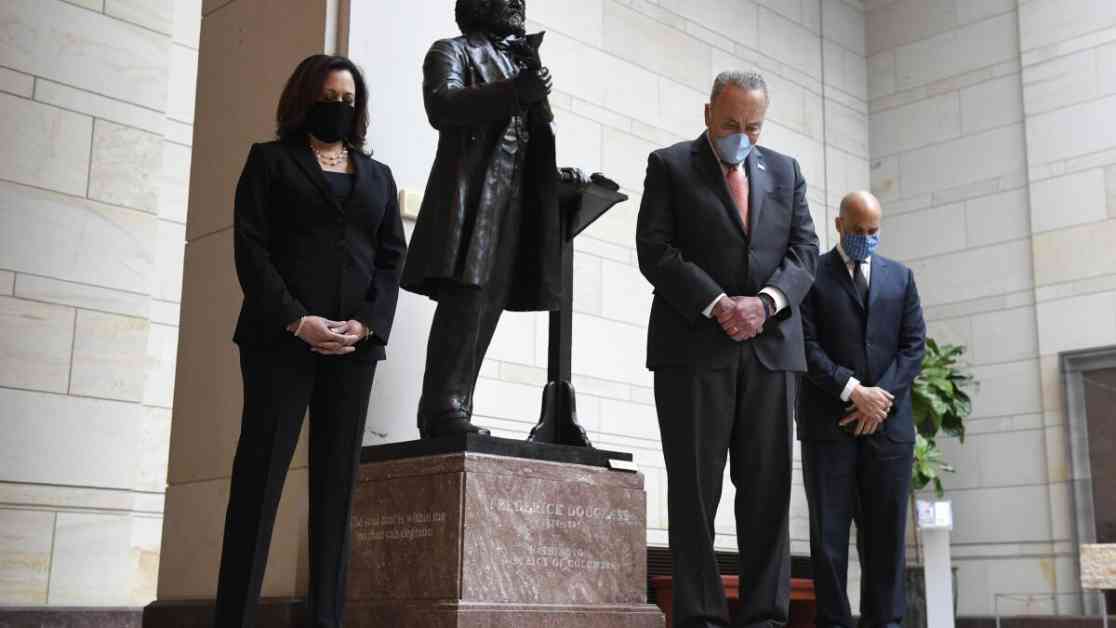Title: Reimagining Safety: Kamala Harris’ Evolving Stance on Police Funding and Public Safety
In the midst of the largest racial justice protests in modern American history, then-Senator Kamala Harris found herself at the center of a heated debate surrounding police funding and public safety. As massive crowds took to the streets to protest police violence against Black Americans, including the tragic death of George Floyd, calls to “defund the police” and reallocate resources to social programs gained momentum.
President Trump dismissed the idea as radical, but Harris, a former prosecutor and author of “Smart on Crime,” saw an opportunity to address the underlying issues at hand. She appeared on “Good Morning America” in June 2020, asserting that the belief in more police equating to greater public safety was flawed. Instead, she advocated for investments in education, healthcare, job opportunities, and sustainable family incomes as key components of community safety.
When asked about the plan by then-Los Angeles Mayor Eric Garcetti to redirect $150 million from the police budget to social programs, Harris expressed her support for the initiative. She emphasized the need to invest in communities to promote health and strength, reducing the reliance on militarized policing. While she clarified that the goal was not to eliminate police entirely, she underscored the importance of practical solutions to address systemic issues.
Harris’s interviews during this period captured a pivotal moment in America’s ongoing struggle for racial justice. It was a time when voices of outrage and demands for reform echoed across the nation, signaling a potential shift after years of stagnation. Harris, who was then a few months away from being selected as Joe Biden’s running mate, spoke passionately and candidly about a deeply entrenched issue that resonated with many Americans.
The Challenge of Reimagining Public Safety
The push to reallocate police funding and reimagine public safety posed a significant challenge to policymakers and activists alike. In Los Angeles, where protests against police brutality had been ongoing for years, the city council faced mounting pressure to address the allocation of resources within the police department. Councilmember Marqueece Harris-Dawson noted that the calls to “defund the police” highlighted the need to reevaluate budget priorities and explore alternative approaches to public safety.
While the concept of defunding the police gained traction in 2020, it also sparked debates about the most effective strategies for promoting community well-being. Harris’s advocacy for redirecting resources from law enforcement to social programs resonated with many who saw a need for comprehensive solutions to address systemic inequalities. However, the practical implications of such a shift raised questions about the feasibility and long-term impact on public safety.
The Complexities of Police Budgeting and Community Investments
As Harris engaged in a series of interviews discussing police budgets and community investments, she emphasized the importance of examining budget priorities and ensuring that resources were allocated effectively. She pointed out the disparities in funding between police departments and essential services like education, highlighting the need for a more equitable distribution of resources to support underserved communities.
Harris’s message resonated with activists and advocates who had long been calling for greater investments in social programs and community-based solutions to address crime and violence. However, the challenge of translating these ideals into concrete policy changes proved daunting, as local governments grappled with competing priorities and budget constraints.
The Impact of the “Defund the Police” Movement
The “defund the police” movement sparked a national dialogue about the role of law enforcement and the need for alternative approaches to public safety. While the slogan itself was controversial and often misunderstood, its underlying message resonated with many who sought to address the root causes of crime and violence in marginalized communities.
In Los Angeles, the City Council’s decision to redirect $150 million from the police budget to social programs reflected a growing recognition of the need to invest in community well-being. However, the implementation of this policy proved challenging, as competing interests and political pressures influenced the allocation of funds.
Moving Forward: Navigating the Complexities of Public Safety Policy
As the debate over police funding and public safety continues to evolve, policymakers and advocates face the daunting task of navigating the complexities of systemic change. Harris’s advocacy for community investments and police reform has been met with both praise and criticism, highlighting the tensions inherent in addressing deep-seated issues of inequality and injustice.
While Harris has distanced herself from the “defund the police” slogan in recent years, her commitment to addressing the root causes of crime and violence remains steadfast. As she navigates the challenges of a rapidly changing political landscape, Harris continues to advocate for progressive criminal justice reforms and investments in community well-being.
In conclusion, the debate over police funding and public safety is far from over. As policymakers grapple with the complexities of systemic change, the need for comprehensive solutions that address the root causes of crime and violence remains paramount. Harris’s evolving stance on these issues reflects the ongoing struggle to reimagine safety in America and build a more just and equitable society for all.



























